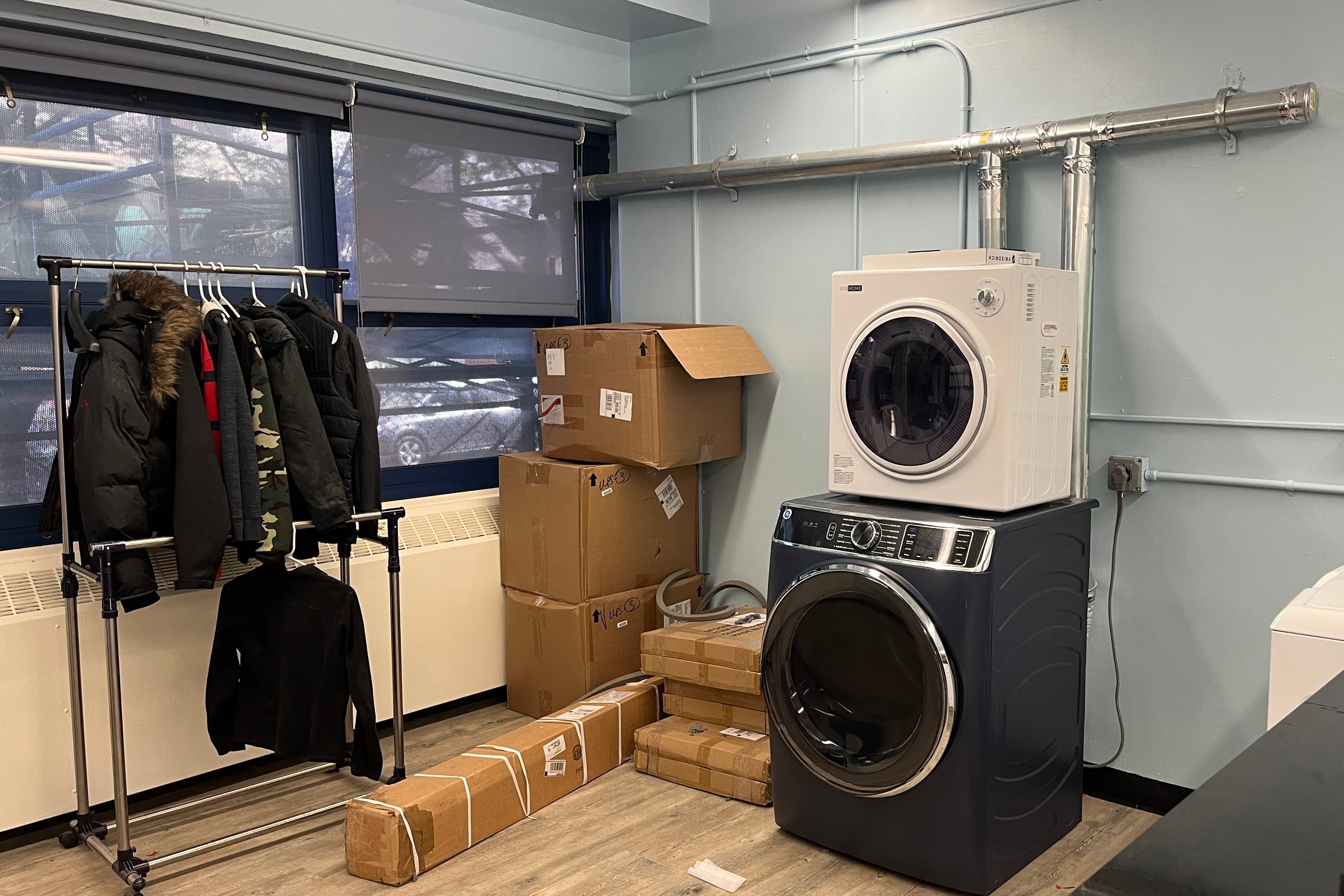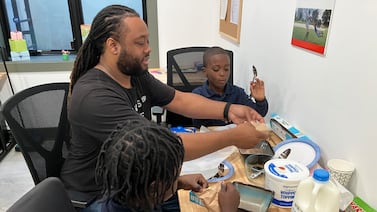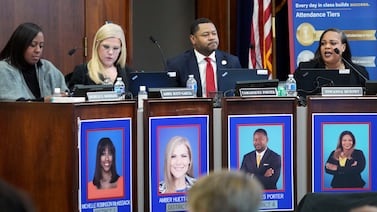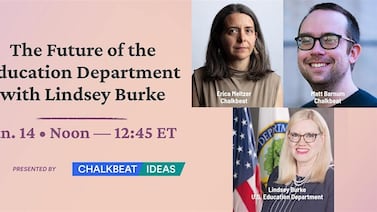Sign up for Chalkbeat New York’s free daily newsletter to keep up with NYC’s public schools.
More than a decade ago, Principal Joseph Mattina noticed students at P.S. 23 Carter G. Woodson were consistently arriving at the Bedford-Stuyvesant, Brooklyn, elementary school without their uniforms.
Initially, Mattina grew frustrated with the students, asking why they couldn’t wear the clothes that had been supplied by the school.
“One day, one of the kids turned around and said to me, ‘Well, it’s dirty, and my mom can’t wash it,’” he said. “That really resonated with me, because it was something that I had never thought of before. It was an obstacle that I didn’t realize existed.”
Today, P.S. 23 is one of just a fraction of the city’s more than 1,600 public schools that offers on-site laundry services, allowing students who live in temporary housing or who otherwise lack access to such facilities to wash their clothes while at school.
As of November 2022, 119 public schools in the city had washers and dryers installed, according to the city’s Education Department.
Still, it’s a tool that some have looked to as a means of combating chronic absenteeism, preventing cases where a lack of clean clothing causes students to miss class. Earlier this year, some lawmakers in Albany sought to make it easier for the city’s schools to install laundry machines — putting forward a bill that would have established a grant program for just that purpose. But that effort stalled after legislators failed to secure funding for it during budget negotiations.
And the need for laundry facilities in schools may be especially relevant this year, as the city’s homeless student population reached a record high and as pandemic-era jumps in chronic absenteeism linger. Last year, roughly 36% of New York City students were chronically absent, meaning they missed at least 18 days of the school year, according to city data.
In New York City, at least one City Council member has been working to draw attention to the issue. In February, Manhattan Council member Gale Brewer sent a letter to schools Chancellor David Banks, seeking additional support for more than 30 schools in her district that were serving students who live in temporary housing but did not have laundry facilities in their buildings.
“I’ve been talking about this for like two years,” Brewer said. “Kids will not come to school if they’re smelly. They just won’t come.”
Community donations support Brooklyn school’s laundry machines
Before P.S. 23 installed its washer and dryers, school staff had tried raising money to purchase laundry detergent on behalf of families who couldn’t afford to pay for laundry services, Mattina said. Still, the financial cost to access laundry machines posed a barrier for some families.
Through community donations, the school was able to install a washer and two dryers — with one of the machines sourced through a local Home Depot, where Mattina said he begged a manager to contribute a dented floor model. But he added that avenue isn’t necessarily available or apparent to other schools.
“When you go to school to be an administrator, they don’t teach you all of these nuances,” he said.
Now, families can come during the school day to wash their students’ clothes, or drop off laundry for the school to clean. Mattina said he frequently throws loads of laundry into the washer in the morning. The school’s speech therapist also shares an office with the machines and often moves clothes over to the dryer, he added.
The result, Mattina said, has been a stronger sense of community among students.
“We’ve always struggled with chronic absenteeism,” he said. Last school year, about 57% of students were chronically absent — though that figure had dropped about 10% from the year prior, according to city data. But he added that kids largely want to attend class and participate in the school community, which recently added a hydroponics lab, sensory room, makerspace, and more to support students.
“We’re trying to create this warm and welcoming environment, and I think it makes a difference,” Mattina said.
The school itself is located near five shelters, with about a third of the student body living in temporary housing, he said.
“Often when we tell parents that we have this service for them, they break down and cry,” he said. “Because of the unspeakable things that they’ve gone through and the trauma that they’ve experienced. This is just one less thing that they have to worry about.”
But funding for the machines, their upkeep, and other associated costs wouldn’t have been possible without community donations. At times, when the school runs out of laundry detergent, they’ve continued to rely on the community.
“We’ve been lucky with the generosity of the public,” Mattina said. “That funding has to come from someplace, because a school can’t sustain it out of their own budget.”
Space, funding pose barriers for many schools
P.S. 23 was fortunate in more ways than one. Its building, constructed in the 1960s, had an old home economics classroom, with sinks and stoves that allowed for machines to more easily be installed, Mattina said.
“Space is an issue,” he noted. “For us, it was fairly easy, because we had an existing room that we were just repurposing. There already was the water line in there, we just had to have the electricity upgraded, and that was an easier fix than actually running in piping.”
But for other schools, it can be far more difficult to install machines.
In Manhattan’s District 3, just seven out of 45 public elementary, middle, and high schools had a washing machine on campus, according to a survey conducted by Brewer’s office. Among those, one school did not have a dryer, while two others reported their washer and dryer no longer worked.
Out of the 38 schools without any machines, 31 had at least 10 students who were living in temporary housing.
For schools seeking to install machines, the financial barriers can be significant. The city’s School Construction Authority told Brewer’s office that upgrades to a school’s electrical and water facilities could cost between $50,000 and $100,000, according to her letter to Banks.
David Clarke, a spokesperson for the city’s Education Department, said the department was “reviewing the letter” and looked “forward to continuing this conversation with her.”
“We believe in supporting the whole child, and that means helping students gain access to the services and resources they need to be successful in our classrooms,” he said in a statement.
Meanwhile, in Albany, a bill sponsored by state Sen. Roxanne Persaud and Assembly member Brian Cunningham, sought to establish a pilot program that would provide funding for laundry facilities to schools with a higher proportion of low-income students — with priority given to schools serving higher shares of students in temporary housing, as well as those with a significant population of students experiencing “frequent absenteeism due to a lack of clean clothing.”
The issue first came to Persaud’s attention in 2022, when a school in her Brooklyn district contacted her about their need for laundry services. Through a collaboration with Lowe’s, Persaud and students from the school were able to secure laundry machines for their community. But in the aftermath, more and more schools expressed having a similar need.
“So we came up with a suggestion: How do we have the state sponsor these laundry rooms?” Persaud said.
At first, Persaud introduced legislation that would have created a statewide program. But after some hesitation from colleagues, it was scaled back to a pilot program based solely in New York City. Though the state Senate allocated $2.5 million to the program in its budget proposal, that funding was ultimately not included in the final state budget agreement, meaning further action on the bill is unlikely to occur this year.
Brewer pointed to “community schools,” which partner with nonprofits to provide wraparound support to students like mental health and dental services, as a broader example of how schools should be supporting their local communities. Some of these schools already offer laundry facilities as part of their services.
“In 2024 and into the future, I think we have to think differently about schools,” she said. “I don’t know that every school needs a washer and dryer, but an awful lot of schools do.”
Julian Shen-Berro is a reporter covering New York City. Contact him at jshen-berro@chalkbeat.org.







